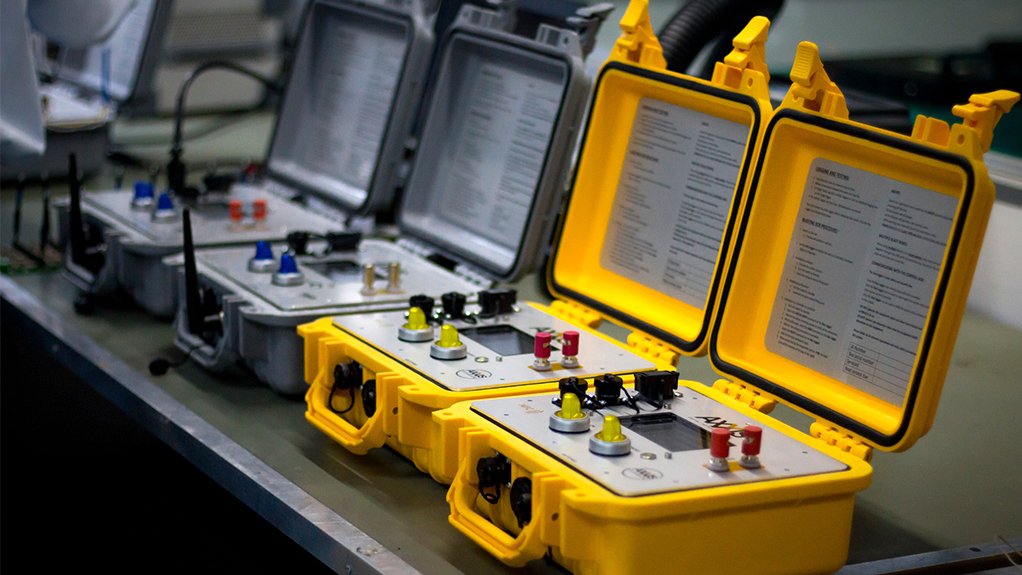A new electronic detonation system, said to be one of the world’s most advanced, has recently been launched.
The blast detonation system is designed to improve safety and quality, with enhanced communication with the detonator during manufacturing to avoid defects. Performance is improved as a result of the increased blast duration per detonator, more units per blasting box and precise firing accuracy.
The Omnia Group company BME asserts that the launch of its AXXIS Titanium system raises the bar globally for the electronic detonator market.
“Most importantly, the AXXIS Titanium system was built for the blaster and blast engineers who work with the product every day,” says BME MD of the SADC region Ralf Hennecke. “The robustness of the wire, the easy-to-use interface and the improved integration will improve efficiency in terms of time, data and reporting.”
“This latest iteration builds on the achievements of the AXXIS GII™ model and raises the bar in many of the features that have served our customers so well,” said BME global product manager for AXXIS Tinus Brits. “These include further refinements in safety, accuracy, flexibility, ease of use and speed in preparing each blast.”
The incorporation of a Swiss-designed application-specific integrated circuit (ASIC) chip in the BME detonators, delivers several benefits, giving the system more internal safety gates against stray current and lightning, enhancing safety levels and allowing for inherently safe logging and testing.
“A unique innovation is our use of dual capacitors and dual voltage, allowing us to conduct low voltage logging to avoid any chance of detonation,” said Brits. Blasts are initiated by a robust, encrypted blast command ensuring that detonators all receive their respective commands and fire as planned. He emphasised that the detonator will only react if it receives the correct, encrypted firing sequence from the blasting equipment, not from any other source.
“We have developed AXXIS Titanium to be resistant to electro-magnetic pulses (EMPs) caused by the blast, which can affect the accuracy of detonators or even cause them to fail,” he added. “Our intensive tests in conjunction with the Council for Scientific and Industrial Research showed that our detonators can withstand a significant EMP without any impact on their timing.”
He noted that underground blasting within confined spaces made detonators particularly susceptible to re-setting and misfiring due to voltages from EMP, as well as from dynamic pressures. Over-moulding of all components on the electronic board protects the detonators against dynamic pressures, and isolates components from any induced ground currents, such as electrostatic discharge and lightning strikes.
The ASIC chip boasts more memory and processing speed, facilitating easier timing and centralised programming if the timing needs to be changed after being conducted on the bench. Power consumption is lowered with the incorporation of dual capacitors, enabling more detonators to be initiated per blast. The system is designed to manage 1 000 detonators per blasting box, doubling the capability of the previous generation.
Brits also noted that up to 20 blasting boxes can be linked and synchronised through hard wiring, enabling the possibility of initiating up to 20 000 electronic detonators in a single blast – double the capacity of the previous model.
BME manager AXXIS support Hennie du Preez highlights additional features such as ease of use and on-bench logging, one-step logging and testing of detonators, as well as simple fault-finding and quick corrections on the blast pattern.
“Everything is built into the logger, which can now do the programming, scanning and testing,” says Du Preez, noting that the speed of the ASIC chip on the system’s board cuts the programming time by half.
The accuracy of the detonation delays has also been improved, reaching a 0.02% firing accuracy. This helps to improve the efficiency of key mine measurables such as loading rates and crusher throughput, and also helps mines to improve their carbon footprints.
Accurate blast design and initiation also allows mines to ensure they are operating within regulatory limits regarding vibration control.
“Commands from the operator are written into the detonator’s non-volatile memory, so that it cannot be over-written or deleted,” says Du Preez. “This is very useful for post-blast analysis if required - even the blast command is recorded by the memory chip.”
He highlights the value of technological integration with BME’s other products, such as its BLASTMAP blast planning software, XPLOLOG platform and cloud-based storage for post-blast analysis. The system also integrates with third-party blasting software.
The company notes that posititve uptake of its new system has already begun in its Southern African market, and the system will soon be rolled out across Africa.
The system is also certified in Australia, Asia and the US, with regulatory processes underway for certification in Canada and the rest of the company’s global territories.
EMAIL THIS ARTICLE SAVE THIS ARTICLE
To subscribe email subscriptions@creamermedia.co.za or click here
To advertise email advertising@creamermedia.co.za or click here













